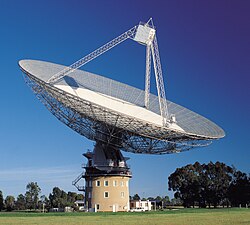CSIRO ScienceImage 11482 An artists impression of one of the two new antennas to be constructed at the Canberra Deep Space Communications Complex CDSCC
Größe:
2657 x 1257 Pixel (2635652 Bytes)
Beschreibung:
In early 2010 construction commenced on a new generation of communication antennas at the CDSCC at Tidbinbilla, ACT. CSIRO manages the CDSCC – one of three DSN stations around the world used for communicating with NASA's spacecraft. The antennas, know as DSS35 and DSS36, will be 34-metre 'dish' constructions know as Beam Wave Guide (BWG) design, meaning the antennas have their transmission and receiving equipment in an underground structure which forms the base pedestal on top of which the main antennas structure and dish are supported. The first antenna to be built, DSS35, will be capable of transmitting across a range of radio frequencies for deep space communication to interplanetary robotic spacecraft. Over the next 10-15 years the planets align in such a way that the Southern Hemisphere will have the best overall view of the existing spacecraft spread out across the Solar System. DSS35 will expand the capabilities of CDSCC providing an additional ante
Weitere Informationen zur Lizenz des Bildes finden Sie hier. Letzte Aktualisierung: Sun, 11 Aug 2024 11:54:48 GMT
Relevante Bilder
Relevante Artikel
Canberra Deep Space Communication Complex
Der Canberra Deep Space Communication Complex (CDSCC) ist eine mit Parabolantennen ausgestattete Deep-Space-Station in Australien. Sie befindet sich südwestlich der Hauptstadt Canberra, im Tal des Murrumbidgee River am Rande des Tidbinbilla-Naturreservats. Die CDSCC-Station ist Teil des weltumspannenden Deep Space Networks. Die offizielle Eröffnung erfolgte am 19. März 1965 durch den damaligen australischen Premierminister Robert Menzies. Die Betriebsführung hat seit März 2003 Raytheon Australia inne, im Auftrag des CSIRO und der NASA.
.. weiterlesen






